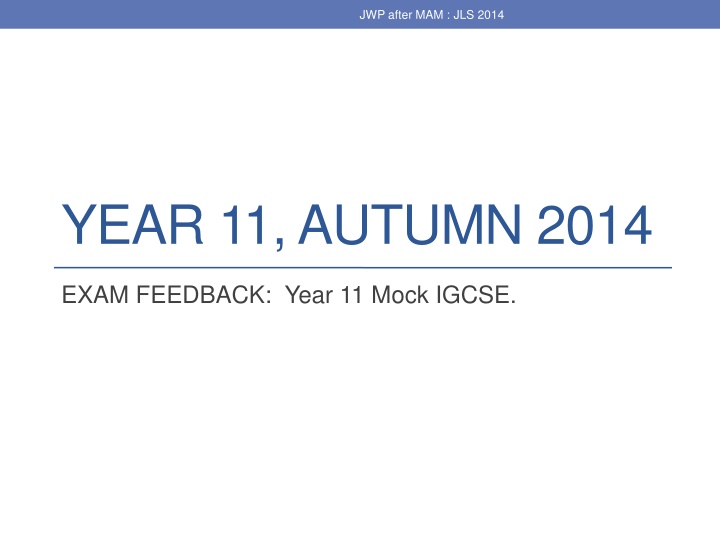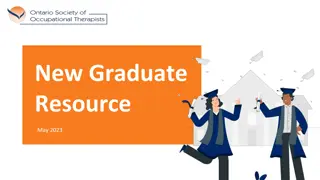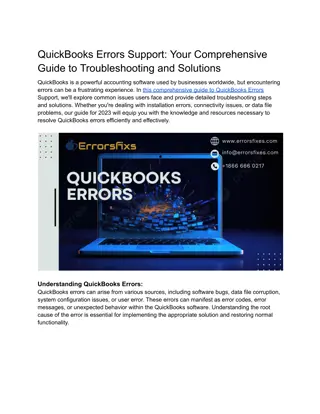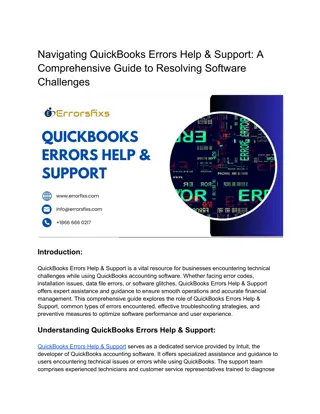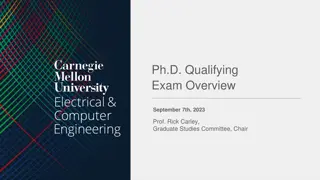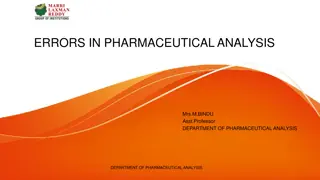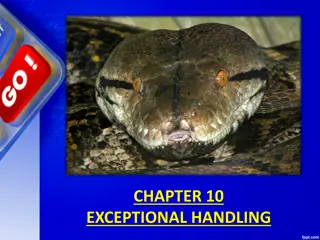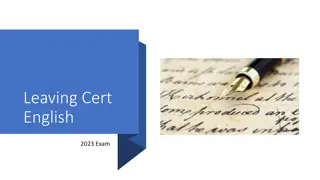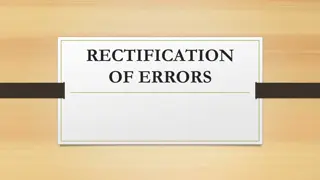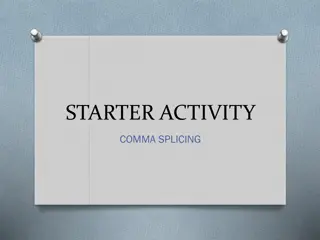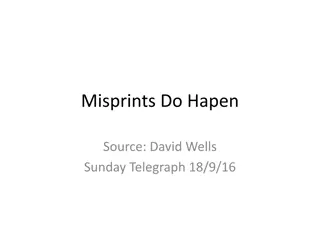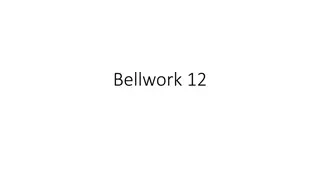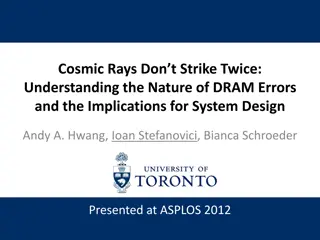Common Errors in Exam Writing Guidance
This feedback provides valuable insights on common errors to avoid when writing exams, such as not following instructions, improper use of quotes, and the importance of clear handwriting. It emphasizes the need to start new paragraphs effectively, use mnemonics like SLIME and SCASI, and provide concise and relevant analysis. Students are advised to improve their writing techniques to enhance their overall exam performance.
Download Presentation

Please find below an Image/Link to download the presentation.
The content on the website is provided AS IS for your information and personal use only. It may not be sold, licensed, or shared on other websites without obtaining consent from the author.If you encounter any issues during the download, it is possible that the publisher has removed the file from their server.
You are allowed to download the files provided on this website for personal or commercial use, subject to the condition that they are used lawfully. All files are the property of their respective owners.
The content on the website is provided AS IS for your information and personal use only. It may not be sold, licensed, or shared on other websites without obtaining consent from the author.
E N D
Presentation Transcript
JWP after MAM : JLS 2014 YEAR 11, AUTUMN 2014 EXAM FEEDBACK: Year 11 Mock IGCSE.
JWP after MAM : JLS 2014 Common errors (overview) Read the instructions! E.g. one passage-based & one whole text question. Write a plan! Hit the ground running when you write but not by writing the second the exam starts: 1st paragraph could mention 3 or 4 techniques used, but must say what effect they have on the reader, and for what purpose. Start new paragraphs with a single sentence about the technique to be discussed (PBQs) OR the section / chapter / episode (WTQs), then use an actual example. DON T repeat exactly what you said in the introductory paragraph. Connotation and denotation ensure you really understand these terms. START using chapter /Act.scene/ page /(line references) They help the examiner; not using them irritates him or her, and muddles YOU. Improve your hand-writing NOW You have less than 6 months to write with less of a slant or to write larger, or to print more (i.e. not join up letters), or to write on alternate lines whatever makes it more legible. LESS COMMON ERRORS ( that create a bad impression and will lose you marks) & instead of and // 1, 2, 3 20, instead of one, two, three // embed quotations // NEVER say: the writer quotes:
JWP after MAM : JLS 2014 Common errors Read the instructions! E.g. one passage-based & one whole text question. Write a plan! Use the mnemonics SLIME, SCASI, etc. and find points for each. Remember that TRAPPERS or AFOREST are mnemonics to help you write better in creative tasks. However, you may recognise them being used by the writers you analyse, Hit the ground running when you write but not by writing the second the exam starts. In other words , your opening paragraph could answer the question with a PQE sentence (quote embedded in it) without re-stating the terms of the question. E.g. Q: What striking impressions of the narrator does Soueif create for you? A: Soueif creates a striking impression of the narrator by using the following main techniques which make us feel and and A: One technique is to use powerful metaphors such as . [QUOTE] A, para 2: Another technique is to break up the long sentences with sudden short ones, such as just after we have learned that This makes us feel It can be helpful to write an opening paragraph that provides an overview of the 3 or 4 main techniques used, but only if you also say: what effect they have on the reader, and for what purpose. You may do all of this withoutusing quotes at the start, but this means that you can t write until you re confident what those main points are.
JWP after MAM : JLS 2014 Common errors (2) Start new paragraphs with a single sentence about the technique to be discussed (PBQs) OR the section / chapter / episode (WTQs), then use an actual example. DON T repeat exactly what you said in the introductory paragraph. Start using chapter / Act.scene / even page and/or line They help the examiner; not using them irritates him or her, and muddles YOU. Improve your hand-writing NOW You have less than 6 months to write with less of a slant or to write larger, or to print more (i.e. not join up letters), or to write on alternate lines whatever makes it more legible.
JWP after MAM : JLS 2014 Common errors (3) Too long-winded: she asks Ann you gained a little weight didn t you darling? , this is intended to make Chris think she is unappealing. The rhetorical question didn t you in conjunction with darling makes it seems as if Mother is trying to be subtle and nice whilst criticising Ann. In this case, the PQE is clear enough without the jargon (mostly in green). Terminology is wrong: Don t tell the examiner what parts of speech are being used (Noun, Verb, Adj, Adv, Prep, Conj, etc.) unless: A) you re certain that s what it is in context; B) you can relate it to a larger pattern (e.g. this character uses a lot of adjectives such as and because they re determined to convey how striking [something] looked and so on
JWP after MAM : JLS 2014 Minor (but depressingly common) errors Irregular past participles: too many (top set!) boys are getting these wrong, e.g. some of you wrote shined instead of shone , and teared instead of tore . Hyphens: almost everyone in the class offended at some point. A hyphen ( - or en-dash ) is used to create a compound noun or adjective, e.g. mind-reader ; self-explanatory . The longer dash ( or emdash ) should have spaces around it, and is used to interject information into a sentence as I m doing right now clarifying some issue.
JWP after MAM : JLS 2014 Denotes & connotes The denotation is the meaning or referent of a word; what the word specifically denotes. A connotation is an additional meaning of, or association with, the word; connotations can provide clues to the subtext of a poem, story, or novel, especially when there are patterns in the connotations of words used by characters. Actual example from a student: in the phrase kick in the teeth , kick denotes violence NO. Kick connotes violence; kick denotes vigorously thrusting with a leg. Here, the student could have pointed out that the speaker is right to be angry but the imagery is so savage that the audience should question his motives [demonstrating awareness of different interpretations], and may anticipate his revenge going wrong [demonstrating awareness of structure].
JWP after MAM : JLS 2014 Implies & infers Implies & infers a writer implies something to the reader through what is said or what happens; you (as the reader) infer ideas from it. Getting this wrong is bad enough, but too many students are saying that particular words imply such and such when that is simply what they mean, in their most common sense. (The correct word, then, would be indicates.) In the exam, you are demonstrating your ability to detect subtext, and explore nuances not to identify the meaning of everyday words. Most of you, at some point, waste time explaining basic vocabulary. It is worth flagging up everyday words if they contrast higher register ones, or reveal the difference between two characters (one more educated, or eloquent and another less so), and so on. If not, assume the examiner gets your point.
JWP after MAM : JLS 2014 Lexical choice This point follows on from the last slide. LC literally means choice from the lexicon (i.e. dictionary). Most words are chosen because they are easy to understand and precise so don t comment on them for the sake of writing something. DON T. You ll be wasting time. The words you should comment on may be part of a metaphor; may be ones that alliterate; may be onomatopoeic; may be speech that has been emphasized by some means; or (and this is perhaps the most valuable thing to discuss) they may be ones that form a pattern in the text because they share connotations with other words. Lexical choices worth commenting on are often those where the register may be higher / lower than normal, or than those used by another character.
JWP after MAM : JLS 2014 Semantic fields A semantic field is a general grouping of words with a shared meaning, or set of associations. SFs should be mentioned rarely if at all. They are relevant when a writer repeatedly chooses words that share connotations so that they gradually build up a distinct image. E.g. All night the flares go up; the Dragon sings And beats upon the dark with furious wings; And, stung to rage by his own darting fires, Reaches with grappling coils from town to town; He lusts to break the loveliness of spires Sassoon describes the sights and sounds of battle as if they refer to a dragon; by uniting the flares and shell-bursts and destruction of church spires within a single semantic field their significance is accentuated. In doing so, he makes the enemy (and war itself) sound evil and inhuman. At the same time, he reminds readers of the story of St George, suggesting England will not only be victorious but saintly. note that the text in green still does not add much. Actual student example: she describes the floor as golden and gleaming which has a semantic field of beauty and perfection Poor grammar aside, this is too vague. The single semantic field that encompasses both words might be treasure , implying just how much the protagonist values what she sees.
JWP after MAM : JLS 2014 Critical language: how and when to use it The writer states (or asserts) that quote use this to introduce a quote when the writer has said something literally and unambiguously; use asserts when it is a strong opinion. Represents to re-present is to make something present (again) to the imagination (i.e. by using a striking image) ; use this verb when decoding a symbol or metaphor in the text Shows use this when you are going to summarize what a text is about (i.e. its themes, moral, etc.) Describes use this when a person or thing is discussed in detail but not necessarily explained or analysed. Portrays implies creating a portrait so use this when a writer has provided a very rich description; depicts is less fancy Refers use this to explain how a particular detail (in the text) is significant because it reminds us of something else Relates use this when explaining how an event or fact is connected to some earlier / later event, or well-known fact. [NB - you can also use relates as a synonym of recounts ]
JWP after MAM : JLS 2014 Critical language (cont.) Alludes when a line (spoken by a character, used by the author, etc.), or a symbol, relates to, or quotes from, some well-known story (especially from a myth, folktale, holy book, etc.). The corresponding noun is allusion. Implies & infers a writer implies something to you through what is said or what happens; you (as the reader) infer ideas from it The writer suggests / hints / intimatesthat use these when a subtle implication has been made (in a passage), or you think you have identified a key message of the text that is not explicitly stated We can assume (or suppose) the writer means use when you are reasonably confident of your interpretation (as above) but there is slightly more ambiguity We might speculatethat but this is a more stylish way of saying that you have guessed the writer s intentions Denotes & connotes every word has a specific denotation but its connotationsare additional meanings and these are what give a piece of writing its subtext, mood, overtones, etc.
JWP after MAM : JLS 2014 SETTING TARGETS: Pick at least two sentences that apply to you and copy the text in bold at the back of your book with the date. I need to check that nouns and verbs agree(e.g. I am not I are ; The ducks were flying not The ducks was flying ). I need to check whether or not to use an apostrophe(e.g. It was Simon scoat not It was Simons coat ; It s cold outside [short for it is ] not Its cold outside ; Its colour is red not It s colour is red ; Theirs is a large house not Their s ). I need to check whether a word needs an apostrophe or is actually a verb ending in s (e.g. he describes not he describe s ). I need to check whether I have said their (a possessive) when I meant there (referring to a place) or they re (they are). Similar mistakes include: were / we re; should have / should of. Write a target in the form above, if you do this. I need to check where to put a full-stop in a sentence, or a semi-colon(e.g. She decided to open the door where she saw her ex-husband standing, this made the lady become angry. This should be two sentences or clauses joined by an S-C). I need to check where to put commas (e.g. after time phrases; never between pronouns and verbs; between items in a list; between multiple adjectives). OTHER ERRORS: I need to use paragraphs when starting new topics; to check for sense; to check for missing words; for repetition of words. STYLE: I need to use more dialogue; to control pace; to vary vocabulary. CONTENT: I need to avoid contradictions; to be more credible; to vary subject matter by reading more; to use a plan so I don t run out of ideas. if you make a mistake more than once, write I STILLneed to check
